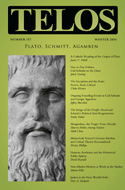Emily Zakin’s “The Image of the People: Freud and Schmitt’s Political Anti-Progressivism” appears in Telos 157 (Winter 2011). Read the full version online at the TELOS Online website, or purchase a print copy of the issue here.
 The origin stories of Schmitt and Freud characterize “the people” as emerging and transmitted through processes of identification and embodied in an image. In both their views, the constitution of a body politic requires, logically and psychologically, a protective boundary that delimits inside and outside and a representation (however mythic or phantasmatic) of authority as the basis for preserving imaginary forms of identification and attachment that anchor bonds of association and provide the requisite boundaries for the unities of ego and nation to form. In this essay I develop the idea that the intensity of association that generates a people is not a metaphysical substance but a metaphysical image. I make use of the Freudian idea of a protective shield that enables an organism to withstand vulnerability and counter excitation with representation, in order to demonstrate that any image of the people is captive to tribal forms of affectivity. I conclude by discussing the danger of replacing the image of the people with the image of universal humanity, an appeal that Schmitt claims can only end in the transformation of cosmopolitanism into the terrifying violence of cosmopartisanship.
The origin stories of Schmitt and Freud characterize “the people” as emerging and transmitted through processes of identification and embodied in an image. In both their views, the constitution of a body politic requires, logically and psychologically, a protective boundary that delimits inside and outside and a representation (however mythic or phantasmatic) of authority as the basis for preserving imaginary forms of identification and attachment that anchor bonds of association and provide the requisite boundaries for the unities of ego and nation to form. In this essay I develop the idea that the intensity of association that generates a people is not a metaphysical substance but a metaphysical image. I make use of the Freudian idea of a protective shield that enables an organism to withstand vulnerability and counter excitation with representation, in order to demonstrate that any image of the people is captive to tribal forms of affectivity. I conclude by discussing the danger of replacing the image of the people with the image of universal humanity, an appeal that Schmitt claims can only end in the transformation of cosmopolitanism into the terrifying violence of cosmopartisanship.


